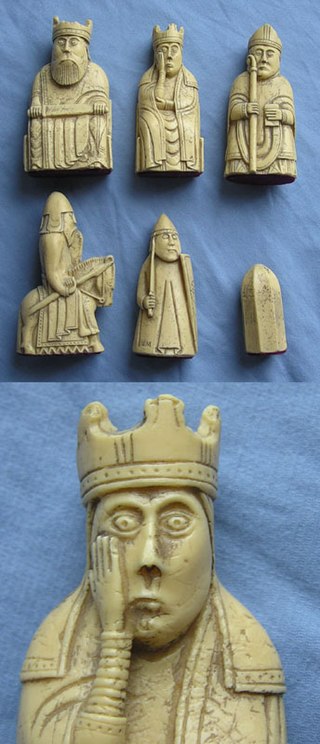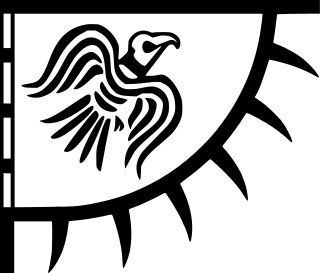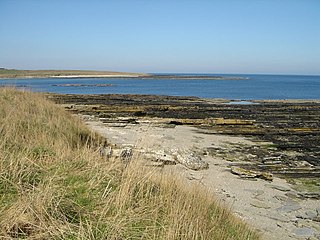Related Research Articles

The Orkneyinga saga is a narrative of the history of the Orkney and Shetland islands and their relationship with other local polities, particularly Norway and Scotland. The saga has "no parallel in the social and literary record of Scotland" and is "the only medieval chronicle to have Orkney as the central place of action". The main focus of the work is the line of jarls who ruled the Earldom of Orkney, which constituted the Norðreyjar or Northern Isles of Orkney and Shetland and there are frequent references to both archipelagoes throughout.
Rognvald Eysteinsson was the founding Jarl of Møre in Norway, and a close relative and ally of Harald Fairhair, the earliest known King of Norway. In the Norse language he is known as Rǫgnvaldr Eysteinsson (Mǿrajarl) and in modern Norwegian as Ragnvald Mørejarl. He is sometimes referred to with bynames that may be translated into modern English as "Rognvald the Wise" or "Rognvald the Powerful".

Earl of Orkney, historically Jarl of Orkney, is a title of nobility encompassing the archipelagoes of Orkney and Shetland, which comprise the Northern Isles of Scotland. Originally founded by Norse invaders, the status of the rulers of the Northern Isles as Norwegian vassals was formalised in 1195. Although the Old Norse term jarl is etymologically related to "earl", and the jarls were succeeded by earls in the late 15th century, a Norwegian jarl is not the same thing. In the Norse context the distinction between jarls and kings did not become significant until the late 11th century and the early jarls would therefore have had considerable independence of action until that time. The position of Jarl of Orkney was eventually the most senior rank in medieval Norway except for the king himself.
Einarr Rognvaldarson, often referred to by his byname Torf-Einarr, was one of the Norse earls of Orkney. The son of the Norse jarl Rognvald Eysteinsson and a concubine, his rise to power is related in sagas which apparently draw on verses of Einarr's own composition for inspiration. After battling for control of the Northern Isles of Scotland and a struggle with Norwegian royalty, Einarr founded a dynasty which retained control of the islands for centuries after his death.
Thorfinn Torf-Einarsson also known as Thorfinn Skull-splitter was a 10th-century Earl of Orkney. He appears in the Orkneyinga saga and briefly in St Olaf's Saga, as incorporated into the Heimskringla. These stories were first written down in Iceland in the early 13th century and much of the information they contain is "hard to corroborate".

The Earldom of Orkney was a Norse territory ruled by the earls of Orkney from the ninth century until 1472. It was founded during the Viking Age by Viking raiders and settlers from Scandinavia. In the ninth and tenth centuries it covered the Northern Isles (Norðreyjar) of Orkney and Shetland, as well as Caithness and Sutherland on the mainland. It was a dependent territory of the Kingdom of Norway until 1472, when it was absorbed into the Kingdom of Scotland. Originally, the title of Jarl or Earl of Orkney was heritable.
Thorfinn Sigurdsson, also known as Thorfinn the Mighty, was an 11th-century Jarl of Orkney. He was the youngest of five sons of Jarl Sigurd Hlodvirsson and the only one resulting from Sigurd's marriage to a daughter of Malcolm II of Scotland. He ruled alone as jarl for about a third of the time that he held the title and jointly with one or more of his brothers or with his nephew Rögnvald Brusason for the remainder. Thorfinn married Ingibiorg Finnsdottir, daughter of Finn Arnesson, Jarl of Halland.
Sigurd Hlodvirsson, popularly known as Sigurd the Stout from the Old Norse Sigurðr digri, was an Earl of Orkney. The main sources for his life are the Norse Sagas, which were first written down some two centuries or more after his death. These engaging stories must therefore be treated with caution rather than as reliable historical documents.

Harald Maddadsson was Earl of Orkney and Mormaer of Caithness from 1139 until 1206. He was the son of Matad, Mormaer of Atholl, and Margaret, daughter of Earl Haakon Paulsson of Orkney. Of mixed Norse and Gaelic blood, and a descendant of Scots kings, he was a significant figure in northern Scotland, and played a prominent part in Scottish politics of the twelfth century. The Orkneyinga Saga names him one of the three most powerful Earls of Orkney along with Sigurd Eysteinsson and Thorfinn Sigurdsson.
Ingibiorg Finnsdottir was a daughter of Earl Finn Arnesson and Bergljot Halvdansdottir. She was also a niece of Kings Olaf II and Harald Hardrada of Norway. She is also known as Ingibiorg, the Earls'-Mother. The dates of her life are not known with certainty.

The Mormaer of Caithness was a vassal title mostly held by members of the Norwegian nobility based in Orkney from the Viking Age until 1350. The mormaerdom was held as fief of Scotland and the title was frequently held by the Norse Earls of Orkney, who were thus a vassal of both the King of Norway and the King of Scots. There is no other example in the history of either Norway or of Scotland in which a dynasty of earls owed their allegiance to two different kings.
Hlodvir Thorfinnsson, was a Viking leader who served as Jarl of Orkney, overseeing the Northern Isles from about 980 to 987. He is mentioned in the Orkneyinga saga, as well as in the sagas of Óláfr Tryggvason and St. Olaf. Beyond the saga records of Hlodvir, little verifiable information is known.
Brusi Sigurdsson was one of Sigurd Hlodvirsson's four sons. He was joint Earl of Orkney from 1014. His life is recorded in the Orkneyinga Saga.
Einar Sigurdsson, also called Einarr rangmunnr Sigurðarson or Einar Wry-Mouth, was a son of Sigurd Hlodvirsson. He was jointly Earl of Orkney from 1014. His life is recorded in the Orkneyinga Saga.
Rognvald Brusason , son of Brusi Sigurdsson, was Earl of Orkney jointly with Thorfinn Sigurdsson from about 1037 onwards. He could possibly be the grandfather of Magnus Barelegs through an unnamed daughter. His life is recorded in the Orkneyinga Saga.
Paul Thorfinnsson and Erlend Thorfinnsson were brothers who ruled together as Earls of Orkney. Paul and Erlend were the sons of Thorfinn Sigurdsson and Ingibiorg Finnsdottir. Through Ingibiorg's father Finn Arnesson and his wife, the family was related to the Norwegian Kings Olav II and Harald II. They are both described as "tall, handsome men, shrewd and gentle, taking rather more after their mother's side of the family. Their lives and times are recounted in the Orkneyinga Saga, which was first written down in the early 13th century by an unknown Icelandic author.
Haakon Paulsson was a Norwegian jarl who ruled the earldom of Orkney together with his cousin Magnus Erlendsson from 1105 to 1123. Their lives and times are recounted in the Orkneyinga saga, which was first written down in the early 13th century by an unknown Icelandic author.
Karl Hundason, also Karl Hundisson, is a personage in the Orkneyinga Saga. The saga recounts a war between Thorfinn Sigurdsson, Earl of Orkney, and Karl, whom it calls king of Scots. The question of his identity and historicity has been debated by historians of Scotland and the Northern Isles for more than a century. However a literal translation suggests that the name may simply be an insult.

Murkle (Murchill) is a small scattered hamlet, made up of East Murkle and West Murkle located one mile (1.6 km) east of Thurso, in Caithness, Scottish Highlands and is in the Scottish council area of Highland.
Helga Moddansdóttir was the mistress of Haakon Paulsson who was Earl of Orkney from 1105 to 1123.
References
- ↑ Stenton, F. M. (1971) Anglo-Saxon England. Oxford University Press, page 362.
- ↑ "The Norse Earls of Orkney". Orkneyjar, the Heritage of the Orkney Islands. Retrieved 30 October 2015.